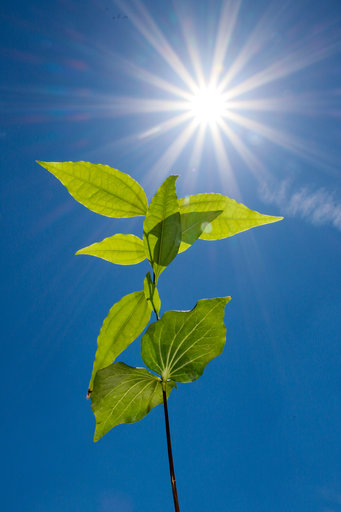Researchers from Jena show how the poison nut tree forms strychnine
A research team at the Max Planck Institute for Chemical Ecology in Jena disclosed the complete biosynthetic pathway for the formation of strychnine in the plant species Strychnos nux-vomica (poison nut). The researchers identified all genes involved in the biosynthesis of strychnine and other metabolites and expressed them in the model plant Nicotiana benthamiana. This enabled them to show that these extremely complex and pharmacologically important molecules can be synthesized using “metabolic engineering” methods.

Poison nut tree Strychnos nux-vomica
© Danny Kessler, Max Planck Institute for Chemical Ecology
Many of us know strychnine from crime reports, novels or films. Agatha Christie had several of her victims die of strychnine poisoning. She described what is probably the best-known fictional murder case involving the highly toxic alkaloid used as rat poison in her first novel “The Mysterious Affair at Styles”. The final clue to solving the case was found by the famous detective character Hercule Poirot in his first literary appearance.
In science, too, investigative instinct and detective work is sometimes required. The researchers led by Benke Hong and Sarah O’Connor from the Department of Natural Product Biosynthesis not only had to find one missing link, but unravel the entire chain of biosynthetic events that lead to the formation of strychnine in the poison nut tree. To stay in the language of crime literature, one could say: They have solved the case!
The chemist and Nobel Prize winner Robert Robinson, who was one of the first to elucidate the structure of strychnine in the 1940s, once described this monoterpene indole alkaloid as the most complex chemical substance for its molecular size. Many chemists were excited by the architecture of the strychnine molecule and developed ways to produce this molecule using chemical synthesis. Surprisingly, however, no one had yet succeeded in finding out how plants produce this natural product.
Comparison of gene activity
Benke Hong’s team has now tackled this mammoth task: “Our key question was how to find the genes responsible for the biosynthesis of strychnine in the poison nut. As a first step, we compared the expression of genes (transcriptome) from two species of the same genus (Strychnos), but of which only the poison nut tree produces strychnine. We selected candidate genes for each step based on the proposed chemical transformation, which we did not know was correct or not,” Benke Hong explains.
The upstream genes of strychnine biosynthesis to the formation of an important intermediate (geissoschizine) have been fully elucidated in the medicinal plant Catharanthus roseus (Madagascar periwinkle), which is also being studied in Sarah O’Connor’s department, and the homologous genes have been identified in the poison nut tree.
Chemical logic
Further progress required a detective’s gift for combining molecular and genetic clues, which scientists call “chemical logic.” “You could say that chemistry guided the discovery of the genes in our study. Based on chemical structures and mechanisms, each step in the metabolic pathway yielded a proposed chemical transformation. In turn, our speculations about the biosynthetic enzyme families with catalytic functions were based on the chemical reaction of each step,” said Sarah O’Connor, head of the Department of Natural Product Biosynthesis, describing the research approach.
As evidence that the identified genes were responsible for the proposed biosynthetic steps, the researchers modified tobacco plants (Nicotiana benthamiana) to temporarily produce the enzymes from Strychnos. After adding the appropriate feed materials, they then investigated whether the hypothesized product was produced by the transformed tobacco plant. This method allowed high-throughput testing of multiple genes simultaneously, which shortened the time required to solve the puzzle.
Prestrychnine converts to strychnine
The researchers were not able to find a corresponding enzyme that catalyzed the last step of strychnine biosynthesis, the conversion of prestrychnine to strychnine. They realized instead that this conversion occurs spontaneously, without an enzyme. As is often the case in both detective work and in science, chance came to the rescue: “The spontaneous conversion of prestrychnine to strychnine is a chance discovery. It requires several intermediate steps, and we initially thought that this process must be catalyzed by one or more enzymes. In fact, we have studied many enzymes, but none of them was reactive. Surprisingly, one day I found that a prestrychnine sample stored at room temperature on the lab bench had slowly converted to strychnine over time,” says Benke Hong.
With the mystery of the last step solved, the researchers were thus able to elucidate the complete biosynthetic pathway of strychnine, as well as the related molecules brucine and diaboline. While brucine is also produced by the poison nut, diaboline is produced by a related species of the genus Strychnos, that does not produce either strychnine or brucine. Notably, the researchers also discovered that only a single amino acid change in one of the biosynthetic enzymes is responsible for the difference in alkaloid accumulation in the poison nut and other Strychnos species.
The elucidation of plant metabolite biosynthesis and the biotechnological use of the genetic basis for the formation of medically important plant compounds in model plants are promising research fields. The current study opens up new possibilities for the production of previously unknown plant natural products using “metabolic engineering” approaches.








